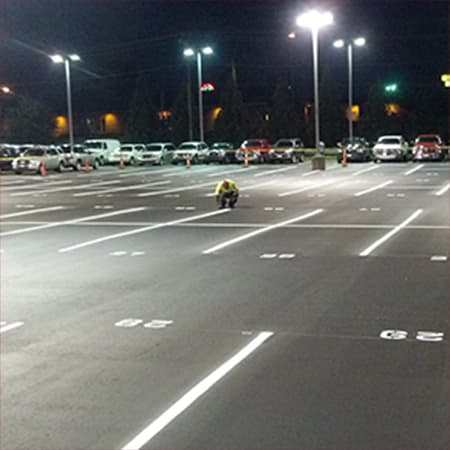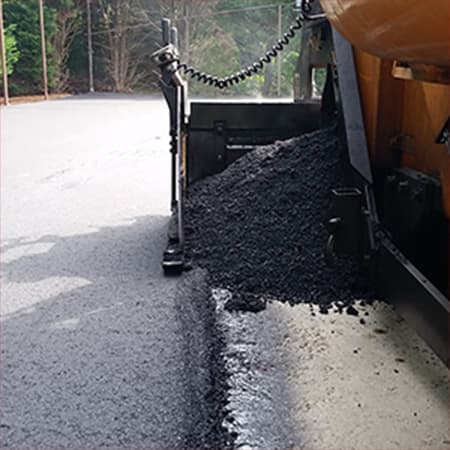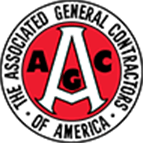Sealcoating Questions – Questions 1-10
The first 10 questions have to do with sealcoating.
Sealcoating is the process of placing a protective coating over the asphalt to help increase the life of the parking lot by reducing oxidation, protecting from gas and oil spills. Additionally it returns the lot to its original consistant black appearance which should probably be considered as an aesthetic benefit. Now lets try to answer the questions. The questions were not in any specific order. I will try to answer them in the order they were given to me which may not be the best.
1. How much will it cost?
Sealer pricing will range depending on size of lot, striping and number of coats. Depending on the lot the pricing is generally less pennies on the dollar compared to the cost of resurfacing or other repairs.
2. What is spider cracking on sealed lots?
Hairlines are very thin cracks, (usually less than 1/16th of an inch wide). They are cracks in the sealcoating, not in the asphalt itself. They are spider web looking, interconnecting cracks, and are usually more apparent when it is wet or damp out. This generally results from too many applications of coal tar products.
3. How did it happen?
We think it occurs because the coal tar cures differently than asphalt and as a result creates this incompatibility after successive applications. Check out this article: http://www.geeasphalt.net/asphalt_competitiveproducts.asp
4. What can I do to fix it?
Using asphalt sealer will generally improve the situation. If you begin sealing your lot with asphalt this problem will never occur. The only way to eliminate them completely would be to re-surface the parking lot.
5. Why should I seal my lot?
Why Seal Coat?
- Seal coating seals the asphalt pavement, preventing the oxidation and erosion of the top layer of asphalt
- On older pavements seal coating replaces fine particles lost from the asphalt surface due to oxidation
- Seal coating seals the small cracks that can turn into large cracks and prevents water from seeping down to the base material.
- Seal coating helps protects the asphalt from the sun as well as the harmful effects of chemical spills such as oil and gasoline.
- Seal coating provides an attractive black surface that is ideal for painting lines and other markers.
- Seal coating leaves a smooth, clean surface ideal for sweeping, lowering cleaning costs.
- Seal coating costs pennies a square foot compared to the dollars needed to repair or replace damaged asphalt.
6. Are there alternatives to coal tar?
Yes there are asphalt based products that are the equivalent of coal tar based sealers and do not have the strong odor, acidic burning or carcinogenic effects.
7. What is coal tar?
Coal tar is a byproduct of the coking process. It is has been used as a preservative and in medicinal products that deal with lice and psoriasis. Coal Tar is thought to be carcinogenic and for that reason was banned in parts of California and Texas for use in sealcoating products. Here is the city of Austin’s brochure on coal tar products: http://www.cityofaustin.org/watershed/downloads/brochure_coaltar.pdf
Here is another good article on coal tar that I think tells the whole story:
http://www.geeasphalt.net/asphalt_competitiveproducts.asp
8. What is asphalt sealer?
Asphalt sealer uses asphalt instead of Coal Tar to make a comparable sealcoating product.
9. What are the benefits of asphalt sealer?
Asphalt based products that are the equivalent of coal tar based sealers and do not have the strong odor, acidic burning or carcinogenic effects.
10. The other contractor said he is going to squeege the sealer. You are spraying. Whats the difference?
In our opinion spraying is the better method. It provides the more consistant coat across the entire surface (in terms of thickness) and without question produces the better finished look. Some websites question whether squeeging may be the better method. Maybe as a first coat application but its benefits are minimal. It is often view that this method does a better job filling cracks and voids. This is really a misnomer. Structurally sealcoatings do not do a good job to fill cracks since the resins in it are not flexible enough to deal with the movement in asphalt. As a result there is only minimal benefit to fill the cracks using the squeegee method. Squeegees tend to drag on the surface leaving the coating thin on the wear part of the surface where it is needed the most. Proper spray applied asphalts tend to outperform squeegee applied applications.
Spraying vs. Sealing is not the end of the story. There is one other method that is worth mentioning – Brush Application. “The bristles of the brush push the sealer deep into the pours and fill in all the little nooks and crannies. ” (http://www.sealcoat911.com/about2.html),
The author of the above reference however recommends a squeegee application as the finish coat to the brush application. We have experimented with this and are not satisfied with this process. In our opinion there are 3 options to sealing:
1. 2 coat spray
2. 1 coat brush
3. 1 coat brush and 1 coat spray.
Number 3 is the best choice albeit the most expensive process. While the jury is still out our results indicate that 1 coat brush is better and slightly less expensive than 2 coat spray. But the brush / spray 2 coat process is by far the best.
Find Your Paving Solution





